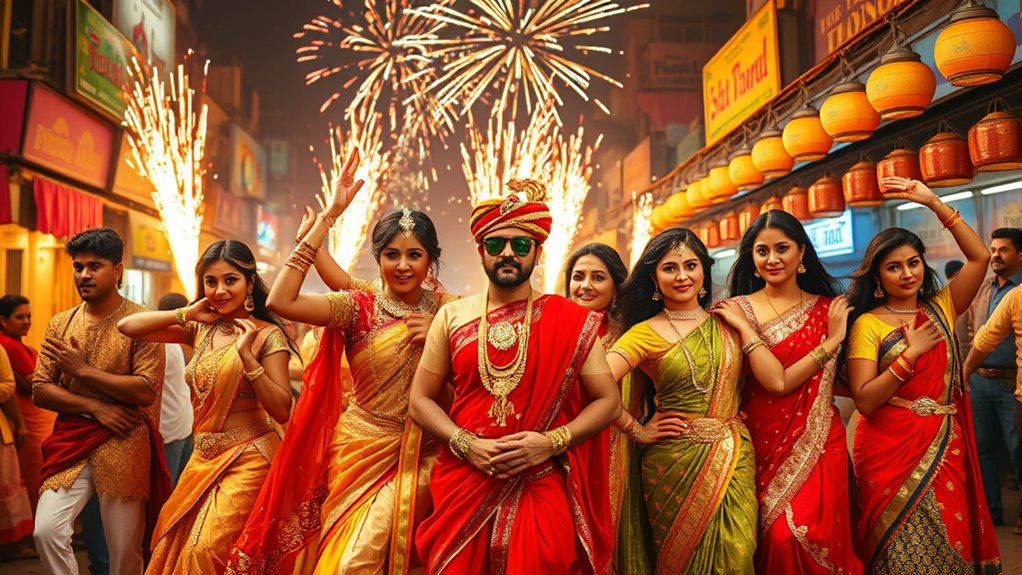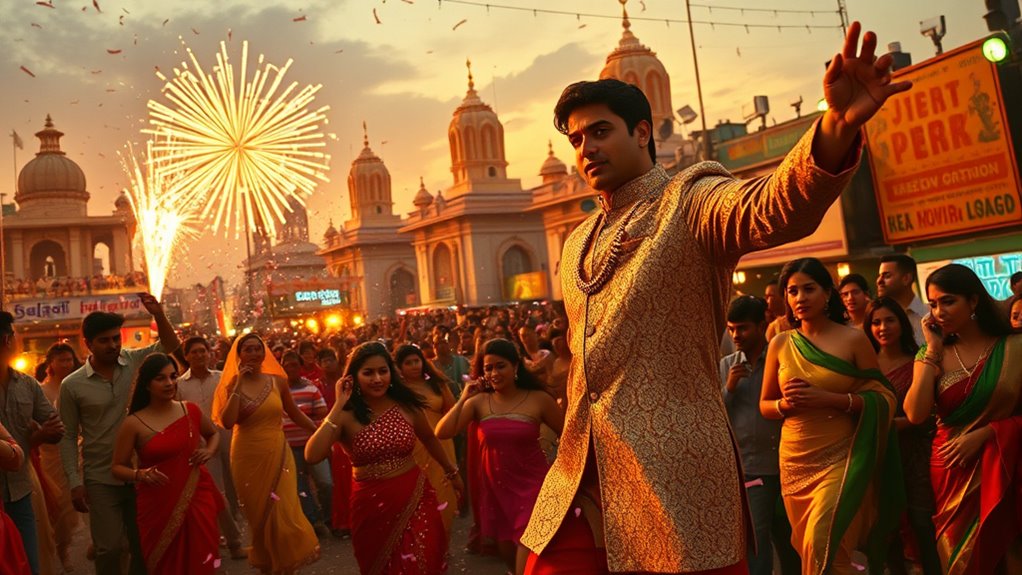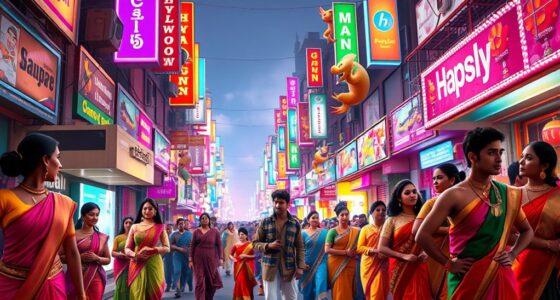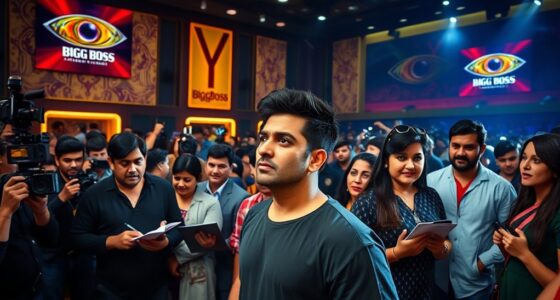A masala film is an energetic Indian movie that mixes genres like drama, romance, action, comedy, and song sequences into one vibrant package rooted in Bollywood traditions. It originated in the 1950s and 1960s when filmmakers combined different styles to entertain broad audiences with cultural influences, regional customs, and universal themes. Over time, it evolved to include modern issues and cinematic techniques. If you keep exploring, you’ll discover just how diverse and lively these films can be.
Key Takeaways
- A masala film blends multiple genres like drama, action, romance, comedy, and musical numbers into a single vibrant package.
- Originated in the 1950s-60s Indian cinema as filmmakers combined genres to appeal to broad audiences.
- Incorporates cultural elements such as folklore, regional costumes, and traditional music, reflecting Indian traditions.
- Evolved to include contemporary themes and global cinematic techniques while maintaining genre blending.
- It is a signature Bollywood style that symbolizes colorful storytelling, entertainment, and India’s rich cultural diversity.

Have you ever wondered what exactly a “masala film” is? If you’re new to Bollywood cinema, it’s a term that might seem a bit confusing at first. Fundamentally, a masala film combines multiple genres and tones—drama, romance, action, comedy, and musical numbers—into one vibrant package. This blending isn’t accidental; it’s rooted in Bollywood’s tradition of genre blending, which allows filmmakers to cater to a diverse audience’s tastes within a single film. The term “masala” itself comes from the spice mix, symbolizing a film’s rich, flavorful combination of elements. Over the years, these movies have become an integral part of Indian cinema, reflecting the country’s cultural influences and storytelling style.
The origins of masala films trace back to the 1950s and 1960s, when filmmakers started experimenting with mixing different genres to keep audiences entertained. Instead of making separate films for each genre, they combined them into one, creating a more engaging experience. This approach was driven by the desire to appeal to a broad demographic—villagers, city dwellers, young audiences, and families—all at once. As a result, masala films are deeply rooted in Indian cultural influences, showcasing traditional values, social issues, and regional customs while also embracing modern themes. They often feature elaborate song and dance sequences that are inspired by Indian folk traditions, classical music, and Bollywood’s signature style.
Cultural influences play a vital role in shaping what makes a masala film unique. You’ll notice how these movies incorporate local folklore, religious symbolism, and regional costumes, making them resonate with Indian audiences on a personal level. At the same time, they tend to be globally accessible, with universal themes like love, patriotism, and justice. Additionally, the integration of symbolism and regional storytelling techniques helps to deepen their cultural resonance. Over time, the genre has evolved, incorporating contemporary issues and global cinematic techniques, but the core idea remains the same: blending different elements to create an entertaining, colorful spectacle. Whether it’s a high-octane action scene mixed with heartfelt drama or a comedic subplot woven into a romantic storyline, masala films are designed to keep you engaged from start to finish. They embody the spirit of Indian storytelling—vibrant, diverse, and full of life—making them a distinctive and beloved genre in world cinema.
Frequently Asked Questions
How Do Masala Films Differ From Other Indian Film Genres?
You’ll notice that masala films stand out from other Indian genres because they blend various elements like drama, comedy, romance, action, and musical numbers into one. This genre blending reflects rich cultural influences, creating an entertaining and vibrant experience. Unlike more focused genres, masala films aim to appeal to diverse audiences by combining different storytelling styles, making them uniquely dynamic and widely popular across India and beyond.
Who Are the Most Iconic Directors of Masala Films?
You’ll find that star directors like Manmohan Desai, K. Raghavendra Rao, and Rajkumar Santoshi are iconic in masala films. They bring their signature styles—mixing action, comedy, and emotion—to create blockbuster hits. These directors excel at blending genres, making their films stand out. Their unique storytelling and flair for entertainment have shaped the masala genre, earning them legendary status among fans and critics alike.
What Are Some Famous Examples of Classic Masala Movies?
You’ll recognize classic masala movies by their vibrant musical sequences and action-packed sequences that keep you on the edge of your seat. Films like “Sholay,” “Deewaar,” and “Amar Akbar Anthony” are perfect examples, blending drama, comedy, and romance seamlessly. These movies offer a colorful, energetic experience, showcasing the genre’s signature mix of songs, fight scenes, and emotional moments that have captivated audiences for decades.
How Has the Audience Reception of Masala Films Changed Over Time?
You’ve likely noticed that audience reception of masala films has shifted over time. Today, you might feel a mix of nostalgia for classic hits and curiosity for modern reinterpretations. While some viewers cherish the traditional blend of genres, others appreciate fresh takes that update the masala formula. This evolution keeps masala films relevant, allowing you to enjoy both nostalgic favorites and innovative stories that appeal to contemporary tastes.
Are Masala Films Popular Outside India?
Imagine a lively dance that crosses borders—that’s how masala films are gaining international popularity. Outside India, their vibrant mix of action, comedy, and music appeals to diverse audiences, sparking a cultural crossover. Though they’re rooted in Indian cinema, their universal themes and energetic storytelling help them resonate worldwide, making masala films a global phenomenon rather than just a local staple.
Conclusion
Now that you know what a masala film is, you can see how it’s a true melting pot of genres, emotions, and entertainment. These movies keep audiences on their toes, blending drama, comedy, action, and music into one lively package. They’ve stood the test of time because they’re like a gust of fresh air—never boring and always full of surprises. So, next time you watch one, remember, it’s all about the whole package, not just a single flavor.









